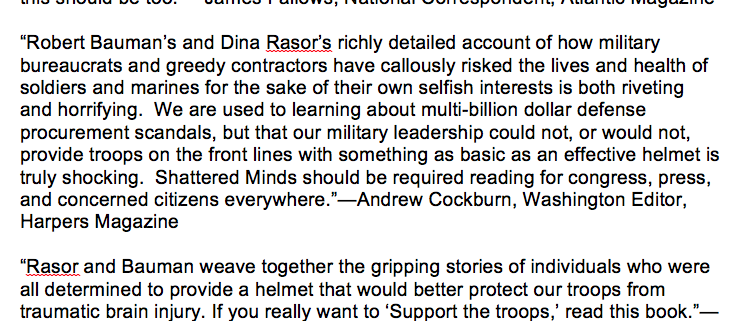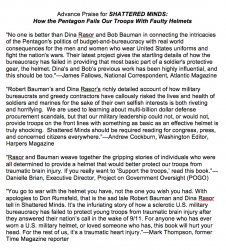Sold: “SHATTERED MINDS: How the Pentagon Fails Our Troops with Faulty Helmets” by Robert Bauman and Dina Rasor
I first blogged about SHATTERED MINDS: How the Pentagon Fails Our Troops with Faulty Helmets in 2016, linking it to a Washington Post story by Ben Guarino about an amazingly hard material found in nature:
Authors Robert Bauman and Dina Rasor were still working on their manuscript in 2016, and I was preparing to begin submitting the project to publishers. There’s an unusual backstory to the book, which I’ll outline below.
In 2008, when I was acquiring books as Editorial Director at Union Square Press, I read a stunning NY Times story about two whistleblowers at a defense contractor in North Dakota who at great personal risk revealed that their employer was knowingly shorting the amount of the protective material Kevlar in the combat helmets they were fabricating for the Pentagon, to increase their profits at the expense of troop safety. At the suggestion of Paul Rieckhoff, founder of Iraq and Afghanistan Veterans of America. I commissioned a book on this grotesque boondoggle to be written by two ace reporters on military procurement and the Pentagon, Dina Rasor and Robert Bauman. In 2009, while they were working on the manuscript, and discovering yet another brave whistleblower to include in the narrative, I left that job and parent company Sterling Publishing canceled the contract, handing the rights back to the authors. Fast forward several years and Bob and Dina approached me to see if in my new role as an agent I would be game to try to help them re-sell the book to a new publisher, which I agreed to, with generous approval from their original agent Bonnie Nadell. This is exactly the type of “imperative nonfiction” I have long cultivated as a publishing professional, and I was very excited to accept the challenge of reselling it to a new publisher. This was part of my pitch letter to publishers:
This revelatory book, written by two authors who’ve covered the Pentagon for many years, reports that in the twenty-first century, while traumatic brain injury (TBI) has become the signature injury suffered by our troops, the defense establishment has failed US fighting men and women by continuing to issue them an antiquated military helmet that fails to mitigate the worst of this tragic harm, even though superior design and technology are increasingly available. This investigation by Dina Rasor and Robert Bauman, the first book to examine this most basic item of military equipment, features the stories of two sets of whistleblowers determined to expose the truth about the failures of the military helmet bureaucracy. Their book braids together the two stories of two sets of whistleblowers to chronicle the helmet scandal and its human impact.
Indeed, in 2017 I sold the book to Potomac Books, a military and public affairs imprint at the University of Nebraska Press, as documented in the deal report below posted at the book industry site publishersmarketplace[dot]com.
Potomac has scheduled the book for publication in March 2019. I’ll post a cover when they have it ready. Meantime, the authors have already received these superb endorsements:
SHATTERED MINDS will set a challenge for technologists, designers, people who use 3D printers, materials scientists, and high level defense thinkers to finally design the most protective military helmet possible. Despite the Pentagon’s failures to this point, we hope to gain their attention to bring new talent and focus to the goal of producing a superior helmet. In the same regard, we are excited about the effort being undertaken by the Head Health Challenge, which also relates to football helmets, an effort that has been covered by Liz Stinson in Wired magazine. I’m hopeful we’ll be able to forge a constructive link between the Defense Dept and the NFL, in as much as the league often cites its cooperation with the US military. I recommend you read the fascinating article by Ben Guarino, which also has video from UC Riverside scientist David Kisailus.





Leave a Reply
Want to join the discussion?Feel free to contribute!